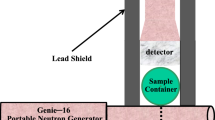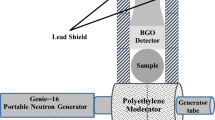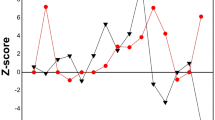Abstract
Previous studies including the development of methods for the determination of carbon, nitrogen, and phosphorus in cattail using cold neutron prompt gamma activation (CNPGAA) and thermal neutron prompt gamma activation analysis (TNPGAA); evaluation of the precision and accuracy of these methods through the analysis of Standard Reference Materials (SRMs); and comparison of the sensitivity of CNPGAA to TNPGAA have been done in the CNPGAA and TNPGAA facilities at the National Institute of Standards and Technology (NIST). This paper integrates the findings from all of these prior studies and presents recommendations for the application of CNPGAA and TNPGAA in environmental studies of plants based on synergistic considerations of the effects of neutron energy, matrix factors such as chlorine content, Compton scattering, hydrogen content, sample thickness, and spectral interferences from Cl on the determination of C, N, and P. This paper also provides a new approach that simulates a sensitivity curve for an element of interest (S), which is a function of hydrogen content (X) and sample thickness (Y) as follows: S = aX + bY + c (where a, b, and c are constants). This approach has provided more accurate results from the analysis of SRMs than traditional methods and an opportunity to use models to optimize experimental conditions.



Similar content being viewed by others
References
Miao SL, Sklar FH (1998) Wetlands Ecol Manage 5:245
Chiang C, Craft CB, Rogers DW, Richardson CJ (2000) Aquat Bot 68:61
Miao SL, Debusk WF (1999) Phosphorus biogeochemistry in subtropical ecosystems. Lewis Publishers, Boca Raton, FL, p 275
Zhao L, Robinson L, Paul RL, Greenberg RR, Miao SL (2005) J Radioanal Nucl Chem 263:805
Zhao L, Robinson L, Mackey EA, Paul RL, Greenberg RR (2008) J Radioanal Nucl Chem 277:275
Zhao L, Robinson L, Paul RL, Greenberg RR, Miao SL (2007) J Radioanal Nucl Chem 271:777
Zhao L, Robinson L (2009) J Radioanal Nucl Chem. doi:10.1007/s10967-009-0309-y
NNDC, National Nuclear Data Center (2009) http://www.nndc.bnl.gov/capgam/indexbye.html
Mackey EA (1994) Biol Trace Elem Res 43–45:103
Anderson DL, Cunningham WC, Lindstrom TR (1994) J Food Comp Anal 7:59
Anderson DL, Cunningham WC, Alvarez GH (1993) J Radioanal Nucl Chem 167:139
Anderson DL, Cunningham WC (1994) Trans Am Nucl Soc 71:21
Paul RL, Lindstrom RM (2000) J Radioanal Nucl Chem 243:181
Paul RL (1995) J Radioanal Nucl Chem 191:245
Mackey EA, Gordon GE, Lindstrom RM, Anderson DL (1992) Anal Chem 64:2366
Paul RL (1997) Analyst 122:35R
Lindstrom RM (1994) Biol Trace Elem Res 43–45:597
Mackey EA, Copley JRD (1993) J Radioanal Nucl Chem 167:127
Johnson E, Robinson L (1989) Rev Sci Instr 60:3447
Acknowledgements
Financial support for this project was provided by the U.S. Department of Education Title III program, the National Oceanic and Atmospheric Administration Education Partnership Program’s Environmental Cooperative Science Center housed at Florida A&M University, and the U.S. Department of Energy through a program administered by Oak Ridge Associated Universities. Many thanks to R. L. Paul, E. A. Mackey, R. R. Greenberg, and R. M. Lindstrom at NIST; S. L. Miao at Everglades Department, South Florida Water Management District, E. Johnson, R. Gragg, and K. Milla at Florida A&M University; and L. Edmiston, C. Bedee, L. Levi, and K. Miller at the Apalachicola National Estuarine Research Reserve.
Author information
Authors and Affiliations
Corresponding author
Rights and permissions
About this article
Cite this article
Robinson, L., Zhao, L. Effects of sample and spectrum characteristics on cold and thermal neutron prompt gamma activation analysis in environmental studies of plants. J Radioanal Nucl Chem 282, 199–204 (2009). https://doi.org/10.1007/s10967-009-0310-5
Received:
Accepted:
Published:
Issue Date:
DOI: https://doi.org/10.1007/s10967-009-0310-5




